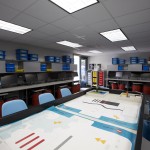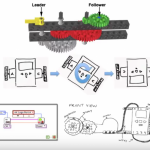Any teacher using LEGO robotics in the classroom quickly develops strategies for dealing with the multitude of plastic pieces. Here are some suggestions.
Kits
Ideally, each pair or small group of students should have its own kit. That way, projects can last for multiple class periods and each group can be made responsible for a particular kit.
If groups in different classes must share kits, the same basic build (a simple car, for example) can be used for all of the groups, with individual groups able to program the robots and make small physical changes to them.
Project bins
For classes where each group has its own kit, it make sense to assign each group a separate project bin, in addition to the kit, to hold work in progress. A bin roughly the size and shape of the NXT/EV3 kit bin offers a generally adequate amount of space without causing a storage nightmare.
Additional LEGO pieces
The NXT and EV3 kits offer a good collection of pieces for basic projects. However, for bigger or more complicated projects, additional pieces are useful. Resource/expansion sets are sold for both the NXT and the EV3. In additional all LEGO and Technic pieces are compatible with the LEGO robotics sets.
Batteries
The NXT and EV3 can be used with either disposable or rechargeable batteries. If rechargeables are used, they will last for several class periods. One method of dealing with changing batteries is to have two bins in the classroom, one for fully charged batteries and a second for batteries that need to be charged. When students need a new battery, they leave the depleted one in the to-be-charged bin and take a fresh one from the fully-charged bin. Of course, this method necessitates having a few extra batteries. Another possibility is to have each group plug its robot into a charger between classes.
Computers and projectors
Ideally, each group has its own computer to use during the class. If one computer per group is not available, it is possible to do some of the projects with groups sharing computers. However, activities that require a substantial amount of programming are difficult without a computer for each group.
Another useful item is a projector or smart board. With this equipment, the entire class can view and discuss a program at once. This option is especially valuable for introducing new programming techniques and for viewing class data from experiments.
Barbara Bratzel
Latest posts by Barbara Bratzel (see all)
- New Cycles of Dr. E’s Challenges Are Here - 7 February 2019
- Snail Car - 23 August 2018
- Ramp Climber - 23 August 2018
- Does LEGO BOOST Have a Place in Education? - 20 January 2018
- EV3 books - 4 July 2017


